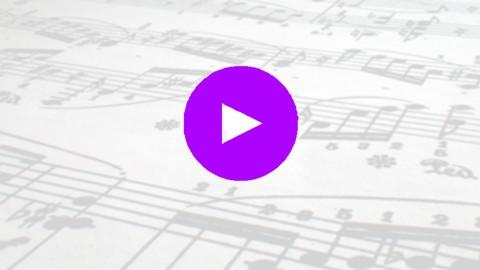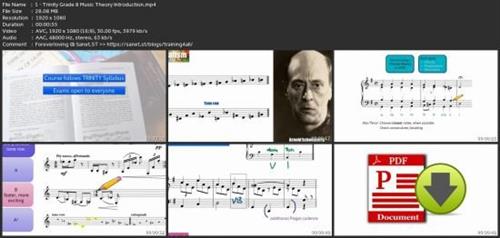Trinity Grade 8 Music Theory
Published 10/2024
MP4 | Video: h264, 1920x1080 | Audio: AAC, 44.1 KHz
Language: English | Size: 845.31 MB | Duration: 2h 27m
A complete course covering the Trinity Grade 8 Music Theory syllabus.
What you'll learn
Pass Trinity Grade 8 Music Theory with Distinction!
Build on your knowledge of how music works, and how to pass the Trinity exam
Further your skills in composition and harmony
Practise your skills with the included PDF, exercises and tests!
Requirements
You should already have covered the topics in Trinity Grades 1-7 Music Theory
You don't need any extra equipment or software to take this course - all materials are provided.
You need to be motivated to learn how music works
Description
Grade 8 Music Theory TrinityThis Grade 8 Music Theory video courses covers the Trinity syllabus in full.FormThe concerto - the number and type of movements likely to be found in Baroque, Classical and Romantic concertos - definitions for each as defined in the workbookThe cadenzaÉtudeNocturne/Song without wordsThe LiedMazurkaPreludeWaltzComposers and General KnowledgeRomantic period as defined in the workbookSerial technique as defined in the workbookComposers of particular relevance to this grade are those writing in the Romantic period (approximately 1830-1900), e.g. the later works of Beethoven and works by Brahms, Chopin, Mendelssohn, Schubert and SchumannPitchRecognising and writing all Dorian mode and whole-tone scalesRecognising and writing all Mixolydian mode scalesIdentifying an extract written using Mixolydian modeRecognising and writing serial tone rows (and their retrogrades)Writing a melody of 12 or 16 bars in length using notes from the major, minor, pentatonic major, pentatonic minor, blues or whole-tone scales or using notes from the Aeolian, Dorian or Mixolydian mode or a serial tone rowWriting an effective modulation through a pivot chordRecognising and writing passing 6/3 and 6/4Recognising and writing chromatic chords - the Neapolitan 6th, augmented 6th chords (Italian, French and German), secondary dominants, borrowed chords from the tonic minor keyRecognising and writing suspensionsHarmonising two phrases of a chorale in an appropriate style (no bass line given and modulation will normally be necessary)Recognising features of Romantic piano/orchestral composition as defined in the workbookTransposing music for any transposing instruments for the grade (transposing interval to be known include those for Grades 6 and 7 and also piccolo, cor Anglais, cornet in Bb, xylophone and glockenspiel)Ranges of piccolo, cor anglais, cornet in Bb, tuba, xylophone, glockenspiel, as defined in the workbookLayout of Romantic scores (for orchestra/concertos) as defined in the workbookMusical terms and symbols
Overview
Section 1: Introduction
Lecture 1 Trinity Grade 8 Music Theory Introduction
Section 2: Scales, Keys and Key Systems
Lecture 2 Parallel Keys
Lecture 3 Mixolydian Mode
Lecture 4 Serialism and Tone Rows
Lecture 5 Serialism - How to Sound Atonal
Lecture 6 Serialism - How to Compose
Section 3: Chords
Lecture 7 Extended Dominants
Lecture 8 Chromatic Chords
Lecture 9 Neapolitan 6th (♭II)
Lecture 10 Secondary Dominants
Lecture 11 Augmented 6ths
Lecture 12 Borrowed Chords
Lecture 13 Chord iv (Minor Subdominant in Major Keys)
Lecture 14 Chord ♭VI (Flattened Submediant in Major Keys)
Lecture 15 Chord ii° (Diminished Supertonic in Major Keys)
Lecture 16 Other Chromatic Chords
Section 4: Voice Leading
Lecture 17 False Relations
Section 5: Chord Progressions and Modulation
Lecture 18 Passing Chords
Lecture 19 Passing 6/4
Lecture 20 Distant Modulation
Lecture 21 Identifying the Prevailing Key
Section 6: Decoration
Lecture 22 Harmonic Analysis with Decoration
Section 7: SATB
Lecture 23 Harmonising a Chorale Melody (with Modulation)
Section 8: Orchestration and Transposition
Lecture 24 Describing Sound
Lecture 25 The Woodwind
Lecture 26 More About Woodwind
Lecture 27 The Brass
Lecture 28 More About Brass
Lecture 29 The Percussion
Lecture 30 Transposing
Lecture 31 Writing an Orchestral Score at Concert Pitch
Lecture 32 Note Names in Other Languages
Section 9: Style and Form
Lecture 33 The Romantic Era
Lecture 34 Identifying the Era of a Score
Lecture 35 The Baroque Concerto
Lecture 36 The Concerto
Lecture 37 The Etude
Lecture 38 The Nocturne
Lecture 39 The Lied
Lecture 40 The Mazurka
Lecture 41 The Prelude
Lecture 42 The Waltz
Section 10: Composition
Lecture 43 Grade 8 Composition Marking Criteria
Lecture 44 Grade 8 Composition Walkthrough
Section 11: Musical Terms
Lecture 45 Musical Terms
Section 12: Practice Test
Lecture 46 Grade 8 Practice Test
This course is for candidates preparing for Trinity Grade 8 Music Theory
Screenshots
Say "Thank You"
rapidgator.net:
ddownload.com:Kod:https://rapidgator.net/file/a20d0921536417c90d83dd019c9b5730/dkayi.Trinity.Grade.8.Music.Theory.rar.html
Kod:https://ddownload.com/6psfe5xxzwat/dkayi.Trinity.Grade.8.Music.Theory.rar
1 sonuçtan 1 ile 1 arası
-
27.10.2024 #1Üye



- Üyelik tarihi
- 20.08.2016
- Mesajlar
- 144.947
- Konular
- 0
- Bölümü
- Bilgisayar
- Cinsiyet
- Kadın
- Tecrübe Puanı
- 153
Trinity Grade 8 Music Theory
Konu Bilgileri
Users Browsing this Thread
Şu an 1 kullanıcı var. (0 üye ve 1 konuk)



 LinkBack URL
LinkBack URL About LinkBacks
About LinkBacks






 Alıntı
Alıntı
Konuyu Favori Sayfanıza Ekleyin